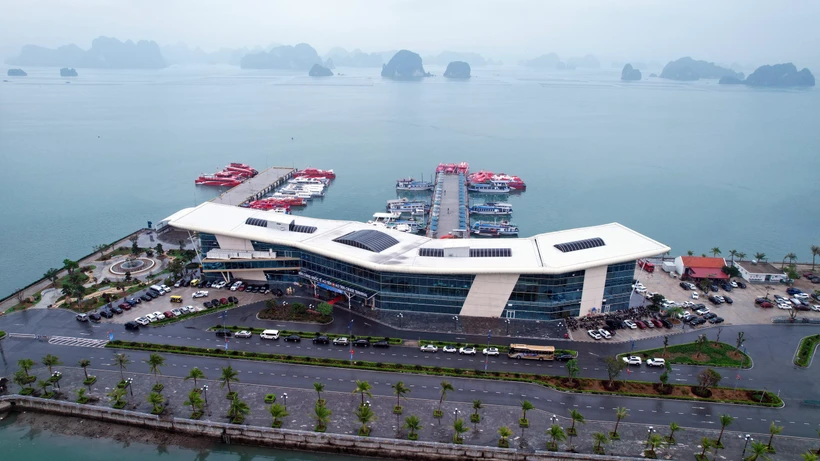WNAM REPORT: The northern province of Quang Ninh has recently launched new tourism routes in Bai Tu Long Bay — a move that marks the beginning of a wider strategy to expand marine and island tourism spaces and ease pressure on the world-famous Ha Long Bay.
Ha Long Bay, a UNESCO World Natural Heritage site, has long been a global tourist magnet, drawing millions of visitors each year. However, this popularity comes with challenges — overcrowding and a lack of diversity in visitor experience. In this context, developing tourism in Bai Tu Long Bay, through a blend of cruise services and eco-experiences on the islands, offers a refreshing alternative and a chance to unlock the area’s untapped potential.
Located within the buffer zone of the Ha Long World Natural Heritage site, Bai Tu Long Bay boasts more than 300 limestone and shale islands. It features majestic, untouched landscapes, and rich ecosystems. The area includes a host of dramatic caves, pristine beaches, and lush primary forests. Notably, the Bai Tu Long National Park has been recognised as the 38th ASEAN Heritage Park, covering over 15,783 hectares and home to more than 2,400 species, including 106 rare animals and plants, making it a prime location for sustainable eco-tourism.
Nguyen Viet Dung, Director of Quang Ninh’s Department of Culture, Sports and Tourism, highlighted that Bai Tu Long is well connected to other attractive destinations such as Co To, Cai Chien, and Tra Co, forming a cohesive tourism network. While Ha Long has established a strong global brand, especially with its luxury cruises and cave tours, Bai Tu Long should pursue a distinct model focusing on immersive, adventurous, ecological, and sustainable tourism.
Former Director of the Department of Tourism and current Vice Chairman of the Quang Ninh Business Association, Pham Ngoc Thuy, said he believes Bai Tu Long should be positioned as a destination for nature lovers, thrill-seekers, and those in search of raw, eco-friendly experiences. He recommends a new model: cruising – discovery – adventure – ecology – marine sports. Unlike Ha Long, where many experiences happen onboard, Bai Tu Long could offer in-depth island exploration with overnight camping, stargazing, and bonfires on the beach.
Thuy also suggested leveraging the area’s natural features – coastal cliffs ideal for rock climbing, trekking routes on islands like Cai Bau and Ba Mun, and marine activities based around coral reefs and diverse sea life. Bai Tu Long Bay could become a haven for sailing, kitesurfing, surfing, diving, and kayaking in sheltered coves. Mountain biking on larger islands like Quan Lan and Ngoc Vung, with their scenic coastal roads, and exploring untouched caves such as Soi Nhu and Phat Co, would add to the tourist eco-experience.
Nguyen Hoai Nam, Business Manager at Vietfoot Travel, emphasised the importance of coupling development with conservation, particularly through waste management to protect the bay’s pristine waters. He also called on businesses to create tourism products linked to local life, turning residents into active stakeholders. Experiences such as fishing with locals, visiting aquaculture farms, and using digital tools to build interactive maps and itineraries can make tourism here more authentic and accessible.
Tour operators agree that Bai Tu Long must carve out a distinct identity from Ha Long. A clear and professional branding strategy is essential, positioning it as a “pristine paradise for adventure, ecology, and ocean sports”. Collaborating with international travel bloggers and influencers (KOLs) will be key to promoting its unique offerings. Applying for global eco-tourism awards could also help place Bai Tu Long on the world travel map.
To realise this vision, Quang Ninh needs to boost promotional efforts, attract green and sustainable tourism investments, and diversify offerings through seasonal tourism to increase visitor stays. Hosting events such as international yacht and sailing festivals, eco-tourism fairs, seafood markets, traditional fishing village exhibitions, and folk performances could breathe life into the destination.
Drawing lessons from Ha Long Bay, many experts stressed the importance of limiting mass development of cruise fleets in Bai Tu Long. The focus should instead be on service quality, environmental protection, and encouraging the use of clean-energy vessels that respect the marine ecosystem.


